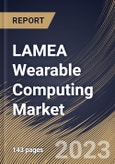Any little technical device with data storage and processing capabilities that may be worn on the body is referred to as a wearable computer. In addition to improving workplaces by providing information rapidly and easily accessible to the wearer, wearable computers are made to be accessible and convenient. Devices are developed and upgraded to seamlessly fit into consumers' lives as human-computer interaction technology advances. These days, wearable technology is always developing and improving, becoming more effective, manageable, and user adaptive.
Technology advancements in wearable devices, expanding consumer acceptance of wearable gadgets like fitness bands & smartwatches, and the increasing popularity of wearable medical and health equipment are the reasons propelling the sales of wearable computing goods. The market for wearable computing is rising due to the growing popularity of smartwatches and fitness bands among athletes, swimmers, runners, gym attendees, and bikers. The Internet of Things (IoT) and wearable technology are becoming increasingly interconnected.
Wearable technology is receiving significant investment from Middle Eastern businesses. Because it may connect both public and commercial sectors, wearable technology has a promising future in MENA (The Middle East and North Africa). Healthcare, banking, aviation, real estate, and building & construction, among other industries, are some of the sectors where wearable technology can be incredibly helpful and advantageous. The devices are proving to be the future of this Smart world, operating with increasing efficiency and precision thanks to the new developments released every two weeks on the market. All these factors are estimated to support the market's growth in the upcoming years.
The Brazil market dominated the LAMEA Wearable Computing Market by Country in 2022 and would continue to be a dominant market till 2030; thereby, achieving a market value of $3,873.1 million by 2030. The Argentina market is experiencing a CAGR of 24% during (2023-2030). Additionally, The UAE market would exhibit a CAGR of 23% during (2023-2030).
Based on Product Type, the market is segmented into Fitness Trackers, Smart Watches, Head Mount Displays, Smart Jewelry, Body-worn Cameras, and Others. Based on Application, the market is segmented into Consumer, and Non-Consumer. Based on Connectivity, the market is segmented into Bluetooth, Wi-Fi, 4G/5G, and Others. Based on countries, the market is segmented into Brazil, Argentina, UAE, Saudi Arabia, South Africa, Nigeria, and Rest of LAMEA.
The market research report covers the analysis of key stakeholders of the market. Key companies profiled in the report include Apple, Inc., Fossil Group, Inc., Garmin Ltd., Google LLC (Alphabet Inc.), Nike, Inc., Samsung Electronics Co., Ltd. (Samsung Group), Sony Corporation, Sensoria Health Inc, Huawei Technologies Co., Ltd., and Xiaomi Corporation.
Scope of the Study
By Product Type
- Fitness Trackers
- Smart Watches
- Head Mount Displays
- Smart Jewelry
- Body-worn Cameras
- Others
By Application
- Consumer
- Non-Consumer
By Connectivity
- Bluetooth
- Wi-Fi
- 4G/5G
- Others
By Country
- Brazil
- Argentina
- UAE
- Saudi Arabia
- South Africa
- Nigeria
- Rest of LAMEA
Key Market Players
List of Companies Profiled in the Report:
- Apple, Inc.
- Fossil Group, Inc.
- Garmin Ltd.
- Google LLC (Alphabet Inc.)
- Nike, Inc.
- Samsung Electronics Co., Ltd. (Samsung Group)
- Sony Corporation
- Sensoria Health Inc
- Huawei Technologies Co., Ltd.
- Xiaomi Corporation
Unique Offerings
- Exhaustive coverage
- The highest number of Market tables and figures
- Subscription-based model available
- Guaranteed best price
- Assured post sales research support with 10% customization free
Table of Contents
Companies Mentioned
- Apple, Inc.
- Fossil Group, Inc.
- Garmin Ltd.
- Google LLC (Alphabet Inc.)
- Nike, Inc.
- Samsung Electronics Co., Ltd. (Samsung Group)
- Sony Corporation
- Sensoria Health Inc
- Huawei Technologies Co., Ltd.
- Xiaomi Corporation
Methodology

LOADING...








